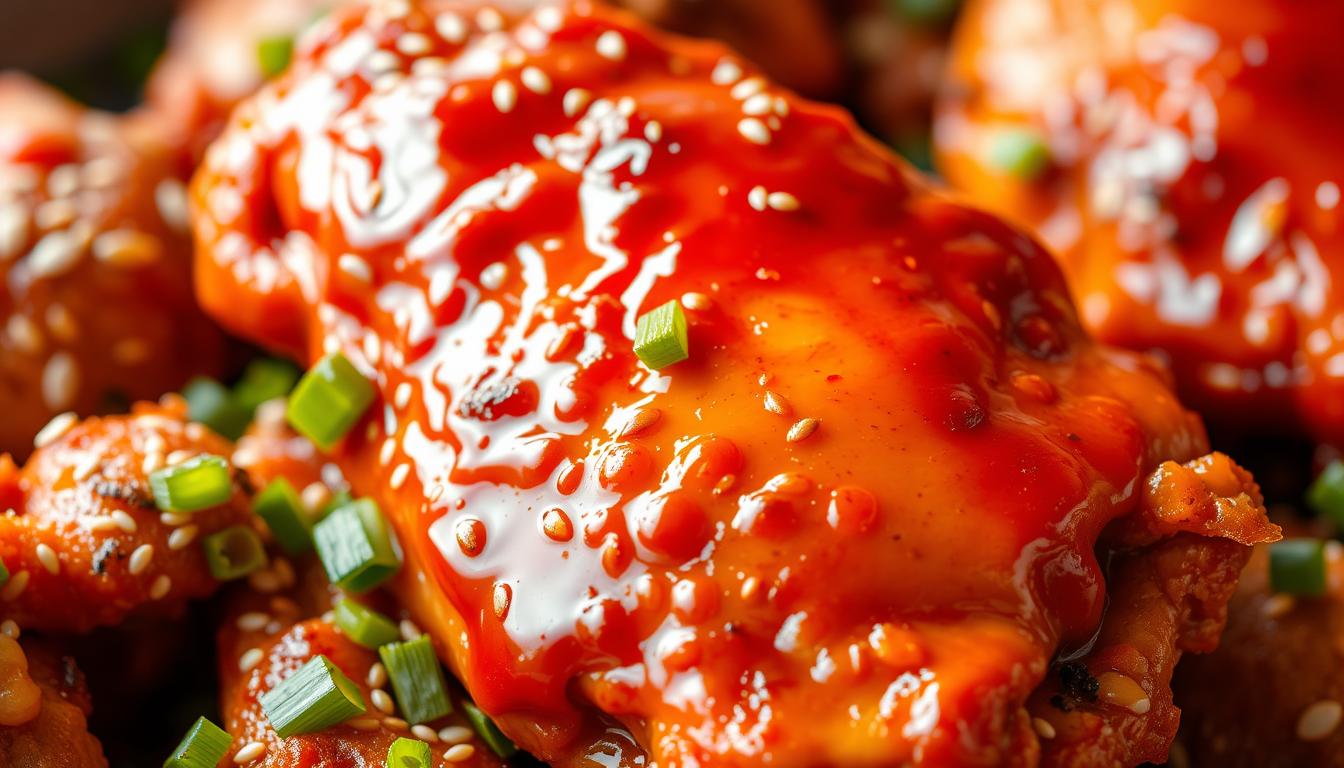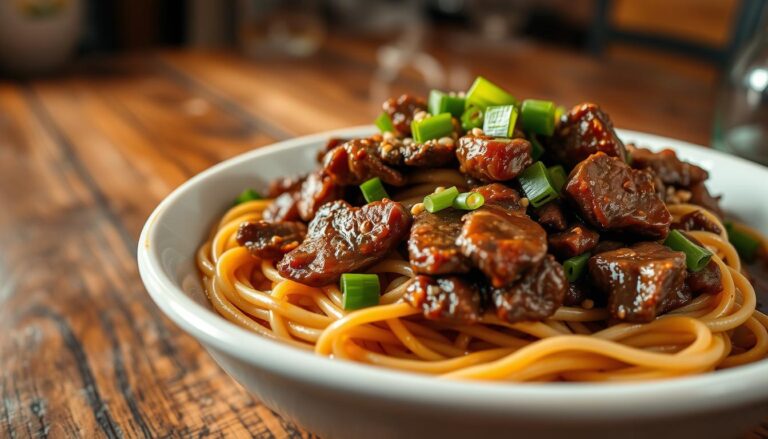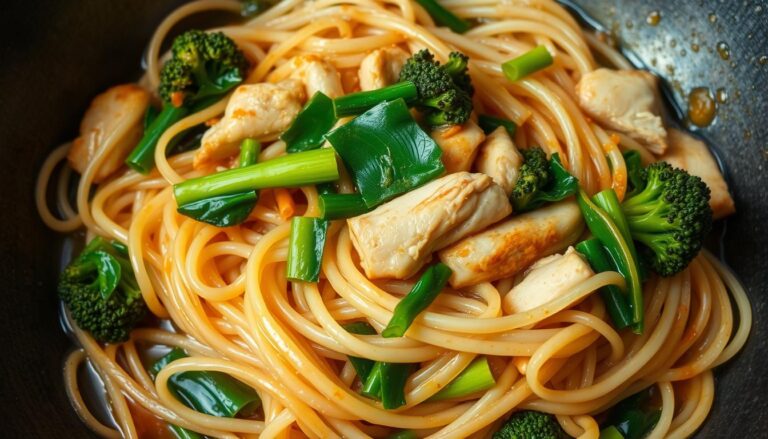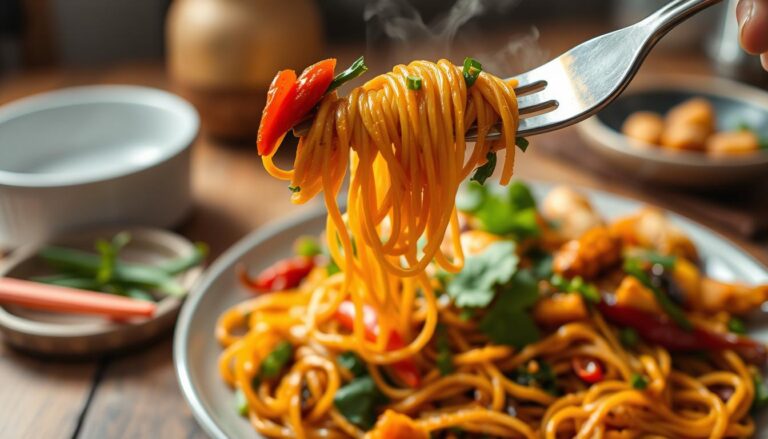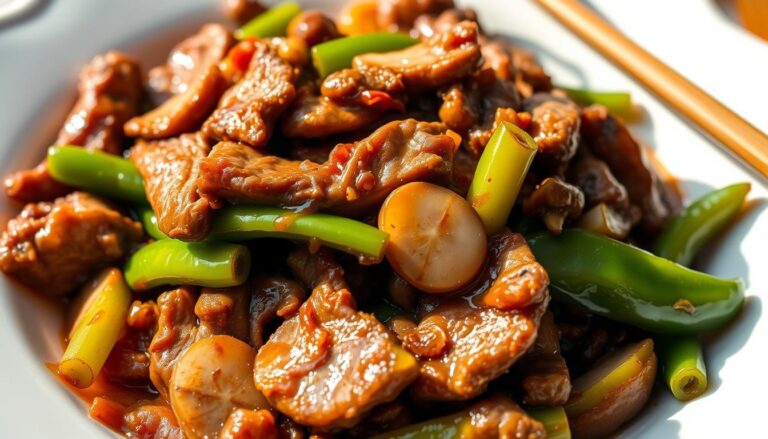Make Spicy Gochujang Chicken: Easy Korean Recipe
Craving bold flavors that wake up your taste buds? This gochujang chicken delivers a fiery-sweet punch you’ll want to eat straight from the pan. Imagine crispy, golden-brown pieces coated in a glossy sauce made with fermented chili paste, honey, and garlic. One bite and you’ll whisper, “Oh my god, it’s so good.”
Our recipe skips complicated steps without sacrificing flavor. Marinate chicken breasts in a mix of soy sauce, brown sugar, and ginger to lock in juiciness. Then, fry them until golden and toss in that addictive gochujang sauce. The result? A sticky, caramelized glaze with layers of heat and sweetness.
This dish works for busy weeknights but feels special enough for guests. Serve it over rice with steamed veggies, and watch it disappear. We’ll walk you through each step—from balancing the sauce’s spice level to reheating leftovers without losing crunch.
Key Takeaways
- Gochujang paste creates a complex, spicy-sweet flavor base for the sauce.
- Marinating ensures tender, flavorful chicken every time.
- Use high heat for a crispy exterior that holds the glaze.
- Customize spice levels with honey or extra chili flakes.
- Pairs perfectly with steamed rice or crunchy vegetables.
Introduction to Korean Flavors and the Appeal of Gochujang Chicken
Korean cuisine thrives on bold contrasts—fiery chili meets mellow sesame, while fermented depths balance bright freshness. At its heart lies gochujang, a brick-red paste born from aged soybeans, glutinous rice, and sun-dried peppers. This umami powerhouse has seasoned dishes for centuries, evolving from royal kitchens to modern home cooking.
Discovering the Unique Taste of Gochujang
Unlike other chili pastes, gochujang offers layered complexity. Fermentation unlocks earthy sweetness, while garlic and soy add savory depth. The heat builds slowly, letting tangy undertones shine. Chefs praise its versatility—it thickens sauces, glazes meats, and even sparks life into soups.
How This Recipe Elevates Everyday Chicken
Our recipe transforms basic chicken into a sticky-sweet marvel. Quick marination with sugar and green onions tenderizes the meat, while the gochujang sauce caramelizes into a glossy coat. Unlike Korean fried chicken, this version skips heavy batter but keeps the crunch through smart pan-searing.
You’ll need just 30 active minutes—most time goes to hands-off marinating. Serve it over steamed rice with a sprinkle of toasted sesame for texture. Later sections break down each step, from balancing heat to choosing the right oil. Ready to make your taste buds dance?
Gathering Ingredients and Essential Kitchen Tools
Every great dish starts with quality ingredients and reliable tools. Before you fire up the stove, let’s break down what you’ll need to create this gochujang chicken recipe with confidence.
Ingredient Overview and Roles
Chicken thighs work best for juicy results, but breasts also work if trimmed properly. Gochujang paste forms the sauce’s spicy-sweet backbone, while soy sauce and sesame oil deepen its umami richness. Brown sugar balances the heat, and fresh garlic cloves add aromatic punch.
For the crispy coating, a mix of flour and cornstarch creates a light crunch. Baking powder lifts the texture, making each bite airy. Don’t skip toasting sesame seeds or slicing green onions—they add freshness and visual appeal.
Must-Have Kitchen Tools for Easy Preparation
A heavy-bottomed pan ensures even heat distribution when frying. Use a deep skillet if you lack a fryer. Measuring cups and spoons help nail the sauce’s balance—too much chili paste overwhelms, while too little sugar dulls the spark.
Prep bowls streamline cooking. Marinate chicken in one, mix dry coatings in another. This mise en place approach saves time and reduces spills. Always preheat oil to 350°F for golden results without greasiness.
With these ingredients and tools ready, you’re set to build layers of flavor and texture efficiently. Now, let’s make that chicken sizzle.
Marinating Magic: Enhancing Chicken Flavor
The secret to unforgettable chicken lies in the marinade. A well-crafted soak transforms tough cuts into melt-in-your-mouth bites while locking in bold flavors. Let’s explore how to master this step for maximum impact.
Marinating Techniques for Tender Chicken
Start with chicken thighs or trimmed breasts—their texture absorbs marinades best. Combine buttermilk, garlic salt, and white pepper in a bowl. The buttermilk’s acidity gently breaks down proteins, while spices infuse depth. “Always massage the marinade into every crevice,” advises chef Ji-Hoon Park. “It ensures even flavor distribution.”
Marinate for at least 1 hour, but overnight works wonders. Keep it refrigerated to prevent bacterial growth. Pat the meat dry before cooking—excess moisture ruins the crispy coating.
Secrets to Balancing Heat and Sweetness
Gochujang brings fiery chili notes, while sugar and honey mellow the burn. A 2:1 ratio of paste to sweetener creates harmony. Add soy sauce for saltiness and sesame oil for nutty undertones. Taste as you mix—too spicy? Drizzle in more honey.
For bold results, let the sauce cling to the chicken during marination. This builds layers of flavor that intensify when cooked. Whether you’re feeding a crowd or just yourself, these tweaks turn simple ingredients into a crave-worthy meal.
Crafting a Crispy Coating and Bold Gochujang Sauce
Achieving the perfect crunch and bold flavor requires mastering two key components: the crispy shell and the glossy gochujang sauce. Let’s break down each element to create restaurant-worthy results at home.
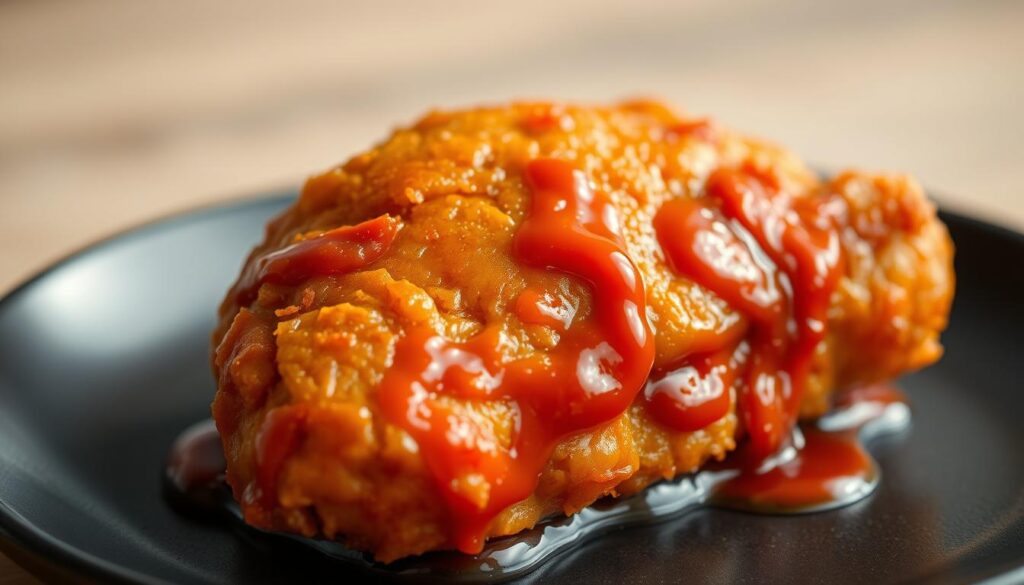
Step-by-Step Process for the Crispy Coating
Start by patting chicken thighs dry with paper towels. Mix 1 cup flour, ¼ cup cornstarch, and 1 tsp baking powder in a bowl. This combo creates an airy, crackly texture. Dip each piece in beaten egg, then press firmly into the flour mix. Let them rest 5 minutes for better adhesion.
Heat vegetable oil to 350°F in a deep pan. Fry chicken pieces in batches for 6-8 minutes until golden. Drain on a wire rack—not paper towels—to keep the coating crisp. “Double-frying boosts crunch,” says chef Mina Kim. “Fry once at 325°F, cool, then again at 375°F.”
How to Prepare a Flavor-Packed Gochujang Sauce
Combine 3 tbsp gochujang paste, 2 tbsp honey, 1 tbsp soy sauce, and 1 tsp minced garlic in a saucepan. Whisk over medium heat until bubbly. Add 1 tsp rice vinegar for tang. Simmer 3-4 minutes until thick enough to coat a spoon.
Toss fried chicken gently in the sauce using tongs. Work quickly to prevent sogginess. Serve immediately with green onions and toasted sesame seeds. For leftovers, store sauce separately to maintain crunch when reheating.
Cooking Techniques for Perfectly Crispy Chicken
Crispy chicken with that signature crunch starts with choosing the right cooking method. Your technique determines whether you get golden, crackling skin or a soggy disappointment. Let’s explore two reliable approaches—deep frying and oven-baking—so you can pick what fits your kitchen and cravings.
Deep Frying vs. Oven-Baking: What Works Best
Deep frying locks in crunch fast. Heat vegetable oil to 350°F in a heavy pan—a bread cube should sizzle immediately. Fry chicken pieces for 6-8 minutes, flipping once. This method creates a sealed crust that keeps the meat juicy. But watch the oil temperature: too low, and your chicken absorbs excess fat; too high, and it burns.
Oven-baking offers a lighter alternative. Preheat to 425°F and place chicken on a wire rack over a baking sheet. The air circulation crisps all sides evenly without flipping. Spray lightly with oil for extra crunch. While less rich than fried versions, this method cuts calories and splatter.
For leftovers, reheat in a 375°F oven for 10 minutes. Avoid microwaves—they turn crispy coatings rubbery. Whether frying or baking, let the chicken rest 3 minutes before tossing in gochujang sauce. This prevents steam from softening the crust.
Chef tip: “Fry in small batches to maintain oil temperature. Overcrowding drops the heat and makes the coating greasy.” Both methods deliver crave-worthy results when you nail the basics. Choose frying for indulgence, baking for weeknight ease.
Tips and Tricks to Optimize the Recipe
Your kitchen is a flavor lab—experiment fearlessly. Whether you crave extra heat or prefer milder notes, these tweaks let you own the dish while keeping its soul intact.
Adjusting Ingredients for Personal Taste
Control spice levels by balancing gochujang paste and sweeteners. Start with 2 tbsp paste + 1 tbsp honey, then adjust. Too fiery? Add ½ tsp sugar. Need more kick? Mix in ¼ tsp chili flakes. “Taste as you go—your tongue is the best guide,” advises chef Lena Cho.
Swap chicken thighs for breasts if you like leaner meat. Thighs stay juicier during high-heat cooking, while breasts benefit from shorter marination (30 minutes vs. 2 hours). For crispier pieces, dust them with cornstarch before frying.
Simplify sodium control by using low-sodium soy sauce or coconut aminos. Garnish with extra green onions or toasted sesame seeds for freshness. Always measure oil quantities—too little causes uneven browning.
Track your tweaks in a cooking journal. Did doubling the garlic improve the sauce? Note it. Small changes, like using dark brown sugar instead of light, can shift the flavor profile dramatically. Your perfect plate is just a few adjustments away.
Exploring Variations of spicy-gochujang-chicken-easy-korean-recipe
Your kitchen becomes a playground when you tweak this adaptable dish. Swap cuts, toppings, and sides to match your mood—no two meals need taste the same.
Choosing Your Chicken Canvas
Thighs deliver juicy richness, perfect for soaking up bold flavors. Prefer leaner bites? Breasts work when sliced thin and marinated briefly. Chef Jae Lee notes: “Bone-in pieces add depth, but boneless cooks faster for weeknights.”
For crispy skin lovers, try air-fried wings tossed in gochujang sauce. Vegetarian? Substitute cauliflower florets—their nooks trap the spicy glaze beautifully.
Garnish Like a Pro
Elevate your plate with texture contrasts. Add extra toasted sesame seeds for nutty crunch or quick-pickled carrots for brightness. Drizzle reserved sauce over steamed rice, or mix chili flakes into mayo for dipping.
Serve in lettuce wraps for low-carb meals or stuff into bao buns with pickled onions. For gatherings, create a DIY topping bar with shredded cabbage, lime wedges, and fried garlic chips.
Experiment with marinades: swap soy sauce for coconut aminos, or add white miso for earthy sweetness. Make it milder with extra honey, or crank up heat with Korean chili powder. Share your creations online—#GochujangTwist could inspire someone’s next dinner!
Conclusion
You’ve just unlocked the magic of turning simple ingredients into a flavor explosion. This gochujang chicken recipe proves that crispy, saucy perfection needs no fancy tools—just smart techniques. From marinating with garlic and soy to nailing the chili-sugar balance in your sauce, every step builds toward that sticky-sweet crunch.
Remember: high heat in the pan creates crackling texture, while resting the meat ensures juicy bites. Whether you choose quick weeknight fried chicken or experiment with oven-baked versions, those golden pieces paired with steamed rice will never disappoint.
Your kitchen is now equipped to riff on this classic. Swap proteins, adjust spice levels, or add toasted sesame for nutty flair. “Great food isn’t about complexity—it’s about bold flavors done right,” says Chef Min-Jee Kim. Share your twist online using #FieryKoreanBites and inspire others.
Ready in under 45 minutes, this dish invites you to play with fire—literally. Whip it up tonight and taste why Korean fried flavors conquer cravings worldwide. Your next culinary victory is just one sizzling sauce toss away.
FAQ
Can I substitute gochujang with another ingredient?
Gochujang’s fermented chili flavor is unique, but in a pinch, mix red pepper flakes, soy sauce, and a touch of sugar to mimic its sweet-spicy profile. Authentic recipes rely on gochujang paste for depth.
How do I adjust the heat level in the sauce?
Control spiciness by reducing the gochujang amount or adding honey for sweetness. Taste the sauce as you mix ingredients like garlic and sesame oil to balance flavors before coating the chicken.
Can I use chicken breasts instead of thighs?
Yes, but thighs stay juicier during frying or baking. If using breasts, marinate them longer (30+ minutes) in the gochujang sauce to lock in moisture and prevent dryness.
What’s the best oil for frying the chicken?
Use oils with high smoke points like vegetable or canola oil. Avoid olive oil, as it burns quickly. For extra flavor, drizzle toasted sesame oil on the cooked chicken.
How do I store leftovers?
Keep leftover chicken in an airtight container for up to 3 days. Reheat in an oven or air fryer to maintain crispiness. Avoid microwaving, as it softens the coating.
Can I bake the chicken instead of frying?
Absolutely! Bake at 400°F (200°C) on a wire rack for 25-30 minutes. Brush the gochujang sauce halfway through to caramelize the glaze without burning.
What sides pair well with this dish?
Serve with steamed rice, pickled vegetables, or kimchi. Garnish with sesame seeds and green onions for freshness and crunch.
Why is my sauce too thick or thin?
Adjust consistency by adding water (1 tsp at a time) for thinness or simmering longer to thicken. The ideal sauce clings to the chicken without dripping.

